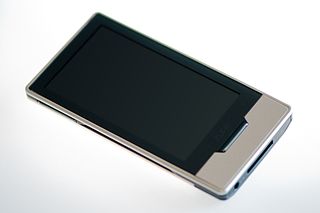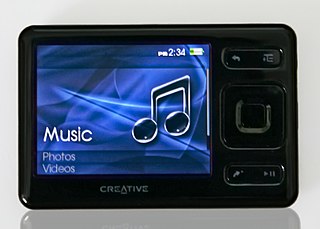
The AirPort Express is a Wi-Fi base station product from Apple Inc., part of the AirPort product line. While more compact and in some ways simpler than another Apple Wi-Fi base station, the AirPort Extreme, the Express offers audio output capability the Extreme lacks. The AirPort Express was the first AirPlay device to receive streamed audio from a computer running iTunes on the local network. AirPort Express outperforms the stringent requirements of the ENERGY STAR Program Requirements for Small Network Equipment (SNE) Version 1.0.

ZEN is a series of discontinued portable media players designed and manufactured by Creative Technology Limited. The players evolved from the NOMAD brand through the NOMAD Jukebox series of music players, with the first separate "ZEN" branded models released in 2004. The last Creative Zen player, X-Fi3, was released at the end of 2011.

Rockbox is a free and open-source software replacement for the OEM firmware in various forms of digital audio players (DAPs) with an original kernel. It offers an alternative to the player's operating system, in many cases without removing the original firmware, which provides a plug-in architecture for adding various enhancements and functions. Enhancements include personal digital assistant (PDA) functions, applications, utilities, and games. Rockbox can also retrofit video playback functions on players first released in mid-2000. Rockbox includes a voice-driven user-interface suitable for operation by visually impaired users.

A portable media player (PMP) is a portable consumer electronics device capable of storing and playing digital media such as audio, images, and video files. The data is typically stored on a compact disc (CD), Digital Versatile Disc (DVD), Blu-ray Disc (BD), flash memory, microdrive, SD cards or hard drive; most earlier PMPs used physical media, but modern players mostly use flash memory. In contrast, analogue portable audio players play music from non-digital media that use analogue media, such as cassette tapes or vinyl records.
Archos is a French multinational electronics company that was established in 1988 by Henri Crohas. Archos manufactures tablets, smartphones, portable media players and portable data storage devices. The name is an anagram of Crohas' last name. Also, in Greek (-αρχος), it's a suffix used in nouns indicating a person with power. The company's slogan has been updated from "Think Smaller" to "On The Go", and the current "Entertainment your way".

The iPod Nano is a discontinued portable media player designed and formerly marketed by Apple Inc. The first generation model was introduced on September 7, 2005, as a replacement for the iPod Mini, using flash memory for storage. The iPod Nano went through several different models, or generations, after its introduction. Apple discontinued the iPod Nano on July 27, 2017.
The Motorola ROKR, the first version of which was informally known as the iTunes phone, was a series of mobile phones from Motorola, part of a 4LTR line developed before the spin out of Motorola Mobility. ROKR models were released starting in September 2005 and ending in 2009. They were notable for incorporating support of media player features.

Yepp was Samsung Electronics' digital audio player brand until Samsung decided to retire most of their family brands in February 2011. From then on, their MP3 players were simply branded "Samsung" worldwide until they discontinued all of them in late 2013. The brand included a wide range of hard-drive based as well as flash-memory based players. The name is claimed to be an acronym for "young, energetic, passionate person".

The Sony Reader was a line of e-book readers manufactured by Sony, who produced the first commercial E Ink e-reader with the Sony Librie in 2004. It used an electronic paper display developed by E Ink Corporation, was viewable in direct sunlight, required no power to maintain a static image, and was usable in portrait or landscape orientation.

The Palm Treo 700p was a cell phone with advanced capabilities, commonly referred to as a smartphone. Unlike the slightly earlier Treo 700w, this model is based on Palm OS. This is the first Palm OS-based Treo model to feature high-speed cellular network support, and is also the first Treo model to support Bluetooth 1.2.

Zune is a discontinued line of digital media products and services marketed by Microsoft from November 2006 until its discontinuation in June 2012. Zune consisted of a line of portable media players, digital media player software for Windows PCs, a music subscription service known as a "Zune Music Pass", music and video streaming services for the Xbox 360 game console via the Zune Software, music, TV and movie sales, and desktop sync software for Windows Phone. Zune was also the provider of music streaming for United Airlines in-flight, after a partnership in 2010.
The following comparison of portable media players compares general and technical information for notable digital playback devices.

My Life Online (Mylo) was a device created and marketed by Sony for portable instant messaging and other Internet-based communications, browsing Internet web sites using the Opera web browser and playback and sharing of media files. The pocket-sized, tablet-shaped handheld device, which debuted in 2006, had a screen which slid up to reveal a QWERTY keyboard. The brand name 'Mylo' means My Life Online. Using Wi-Fi instead of cellular networks, the Mylo was targeted to the 18–24 age group.

SanDisk has produced a number of flash memory-based digital audio and portable media players since 2005. The current range of products bear the SanDisk Clip name, a line of ultraportable digital audio players. SanDisk players were formerly marketed under the Sansa name until 2014.

The ZEN is a portable media player designed and manufactured by Creative Technology. This flash memory-based player is the de facto successor of the ZEN Vision:M and was announced on August 29, 2007, to be available in capacities of 2, 4, 8, and 16 GB, as of September 14. A 32 GB model was announced on December 4, 2007, setting a record for storage capacity among flash players. The ZEN is referred to also by the identifier DVP-FL0001 though this does not appear on the unit.
The Nokia 3600 slide is a mobile phone by Nokia that was released in August 2008. The phone runs the Series 40 3rd Edition platform. This is classed as the 'low end version' of the Nokia 6600 slide, its major difference being the lack of 3G support.
Linksys manufactures a series of network routers. Many models are shipped with Linux-based firmware and can run third-party firmware. The first model to support third-party firmware was the very popular Linksys WRT54G series.

AirPlay is a proprietary wireless communication protocol stack/suite developed by Apple Inc. that allows streaming between devices of audio, video, device screens, and photos, together with related metadata. Originally implemented only in Apple's software and devices, it was called AirTunes and used for audio only. Apple has since licensed the AirPlay protocol stack as a third-party software component technology to manufacturers that build products compatible with Apple's devices.













